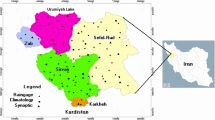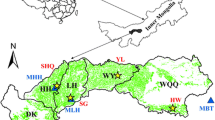Abstract
This study aims in linking the biophysical and socioeconomic data base layers with the technical coefficients or simulation models for agri-production estimates and land use planning under normal and extreme climatic events, and exploring the resource and inputs management options in village Shikohpur, Gurgaon district located in the northwest part of India. The socioeconomic profile of Shikohpur is highly skewed with mostly small and marginal farmers. Though the areas under wheat in Shikohpur are increasing, the productivity is declining or remaining stagnant over the years. Most of the area during kharif season (June–September) remains fallow. Pearl millet based cropping systems (pearl millet–mustard and pearl millet–wheat) are predominant. Soils are mostly loamy sand to sandy loam with average of 70–80% sand content. Organic C content in soil is less than 0.3%, due to high prevailing temperature with little rainfall and also intensive agriculture followed in this region. Though the annual average seasonal rainfall in Gurgaon did not have much variation over the years, occurrence of extreme climate events has increased in the last two decades. The crop intensity is low and the water table is declining. Water and nitrogen production functions were developed for the important crops of the region, for their subsequent use in scheduling of the inputs. InfoCrop, WTGROWS and technical coefficients were used for crop planning and resource management under climate change and its variability, extreme events, limited resource availability and crop intensification. These will help in disseminating necessary agro-advisories to the farmers so that they will be able to manipulate the inputs and agronomic management practices for sustained agricultural production under normal as well as extreme climatic conditions.
Similar content being viewed by others
References
Aggarwal, P. K., Kalra, N., Chander, S., & Pathak, H. (2006). InfoCrop: A dynamic simulation model for the assessment of crop yields, losses due to pests and environmental impact of agro-ecosystems in tropical environments. II. Model description. Agricultural Systems, 89, 47–67.
Aggarwal, P. K., Kalra, N., Singh, A. K., & Sinha, S. K. (1994). Analyzing the limitations set by climatic factors, genotype, water and N availability on productivity of wheat: The model documentation, parameterization and validation. Field Crops Research, 38, 73–91.
Aggarwal, P. K., & Mall, R. K. (2002). Climate change and rice yields in diverse agro-environments of India. II. Effect of uncertainties in scenarios and crop models on impact assessment. Climate Change, 52, 331–343.
Aggarwal, P. K., Roetter, R. P., Kalra, N., Van Keulen, H., Hoanah, C. T., & Van Larr, H. H. (2001). Land use analysis and planning for sustainable food security: With an illustration for the State of Haryana, India (pp. 167). New Delhi: Indian Agricultural Research Institute.
Anand, P., Bansal, H., Kansal, S., Goel, R., Ahmed, O., Mishra, A. K., et al. (2006). Soil information system: Evaluating soil moisture and fertility indices for land capability classification. Bioinformatics India, 3(2), 35–37.
Challa, O. (1999). Land resource evaluation for district level planning: An approach. Journal of the Indian Society of Soil Science, 47, 298–304.
Chander, S., Kalra, N., Pathak, H., Narang, M. S., Mishra, A. K., Sehgal, M., et al. (2006). Linkage of agri-database layers with simulation models to assess the productivity of crops. Proceedings of the Symposium on Geoinformatics Applications for Sustainable Development, Indian Agricultural Research Institute, New Delhi, 110012, February 17–19, 2004, 190–197.
Goldsworthy, P., & Penning de Vries, F. W. T. (Eds). (1994). Opportunities, use and transfer of systems research methods in agriculture to developing countries (p. 336). Dordecht, The Netherlands: Kluwer.
IPCC (1996). Intergovernmental Panel on climate change, 1996. Climate Change – 1995. The science of climate change. (pp. 572) Cambridge: Cambridge University Press.
IPCC (2001). Climate change 2001: The scientific basis. Contributions of working group I to the third assessment report of the Intergovernmental Panel on Climate Change (IPCC). Cambridge: Cambridge University Press.
Kalra, N., Aggrawal, P. K., Chander, S., Pathak, H., Choudhary, R., Chaudhary, A., et al. (2003). Impacts of climate change on agriculture. In P. R. Shukla, S. K. Sharma, N. H. Ravindranath, A. Garg, & S. Bhattacharya (Eds.), Climate change and India, vulnerability assessment and adaptation (pp. 193–226) Hyderabad: University Press.
Kalra, N., Chakraborty, D., Ramesh Kumar, P., Jolly, M., & Sharma, P. K. (2007). An approach to bridging yield gaps, combining response to water and other resource inputs for wheat in northern India, using research trials and farmers’ fields data. Agricultural Water Management, DOI 10.1016/j.agwat.2007.06.004. In press.
Kalra, N., Chander, S., Mishra, A. K., & Seghal, M. (2005). Linkage of agri-informatics with simulation models to assess the productivity of crops. Bioinformatics India, 3(3), 45–51.
Kalra, N., Chander, S., Pathak, H., Mishra, A. K., Sehgal, M., Pillai, M. S., et al. (2004). Use of bio-physical and socio-economic aspects with simulation and decision tools for appropriate land use options and agri-production estimates. Proceedings of the Symposium on Geoinformatics Applications for Sustainable Development, Indian Agricultural Research Institute, New Delhi, 110012, February 17–19, 2004, 202–207.
Passioura, J. B. (1973). Sense and nonsense in crop simulation. Journal of the Australian Institute of Agricultural Science, 39, 181–183.
Passioura, J. B. (1996). Simulation models: Science, education, or engineering. Journal of Agronomy, 88, 690–694.
Satyavati, P. L. A., Sharma, J. P., & Srivastava, R. (1994). Contribution of soil organic matter, clay and silt to the cation exchange capacity of soil. Journal of the Indian Society of Soil Science, 42, 14–17.
Sinclair, T. R., & Seligman, N. G. (1996). Crop modeling: From infancy to maturity. Agronomy Journal, 88, 698–704.
Singh, M. (2006). Development of village information system for land use planning and agricultural productivity assessment (pp. 77). Ph.D. Thesis, PG School, IARI, New Delhi, India.
Author information
Authors and Affiliations
Corresponding author
Rights and permissions
About this article
Cite this article
Singh, M., Kalra, N., Chakraborty, D. et al. Biophysical and socioeconomic characterization of a water-stressed area and simulating agri-production estimates and land use planning under normal and extreme climatic events: a case study. Environ Monit Assess 142, 97–108 (2008). https://doi.org/10.1007/s10661-007-9911-z
Received:
Accepted:
Published:
Issue Date:
DOI: https://doi.org/10.1007/s10661-007-9911-z




